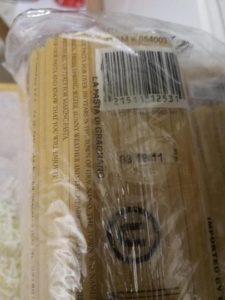Well, let’s pull some stored-for-a-while food off the shelf and see what happens:
 An eight year old pound of spaghetti purchased from Costco. Storage conditions? Put into a plastic tub with a lid and sat on a wire shelf in my basement for the last eight years. Results?
An eight year old pound of spaghetti purchased from Costco. Storage conditions? Put into a plastic tub with a lid and sat on a wire shelf in my basement for the last eight years. Results?
Absolutely fine. Cooked up just as you would expect.
I’m not surprised. There are foods that you need to very deliberately and carefully package away for storage and there are some that are just….bulletproof. My experience has been that pasta, kept dry and vermin-free, keeps pretty much indefinitely. In this case, I just proved it’ll last at least eight years.
Another food that requires, basically, zero babying is rice. I kid you not, I had a 15-gallon blue barrel full of rice from my Y2k stash and ten years later it was just fine with the only attention in its packaging having been to pour it into the barrel and screw on the lid. I would bet you that rice poured into a clean jar with a tight fitting lid would last virtually forever.
Does that mean these are the optimal ways to store these particular items? Heck no. But what it does mean is that you can sock away pounds and pounds of a staple food that goes a long way towards helping to stretch out your other foods and do it without a lot of effort.
My experience, and your mileage may vary, is that in my climate and in my house I can take these plastic sealed packages of pasta, stuff ’em into a plastic tub with a tight fitting lid, tuck them away on a shelf in a cool dark place, and it stores just fine.
I suppose if you live in the south or some other equally humid environment its a different story, same if youre in an environment that is known for creepy crawly things, but where I live it’s practically a high-altitude desert.
The point, if there is one, is that some foods just lend themselves to longish storage periods without a lot of fancy prep and packaging.

yeah down here in the south my y2k barrel of rice ended up black with bugs and rancid. it was sealed in the same kind of blue barrel with desiccant. i didn’t know about o2 absorbers or mylar back then. it was heart breaking to dump all that out but a valuable lesson.
Upstate NY here. We’re fairly humid, thanks to the Great Lakes. All non-liquid things that I put away for storage (even short term) get moisture absorbing silica packets added to the containers. While not perfect, it helps alot, and I’ve lost far less to mold since I started doing so.
Rice – mason jar with a food saver pulling all air out of the jar. 9+ years.
Beans – same.
Pasta – same.
Cereal – same prep 4 years, would of went longer I think but we ate it.
Jarred in Florida, moved to Mississippi, headed to Illinois (don’t get me started.)
If you would like more details on how we have jarred different things let me know.
Living in the Deep South, the major problem I have seen with any grain or bean is not degradation of the product itself but with the inevitable hatching of weevils/beetles whose eggs – I’m sure – were present in the field or in the processing facility. Any issues with that?
Makes sense to me, and why my parents told me to put long term food in the freezer for a week before putting in the bucket. Alternatively, you can add food grade vermiculite and stir well, as long as you don’t mind a few extra bug carcasses.
Weary of digging frozen foods out the bottom of my freezer chest, I decided to fill the bottom 20+ inches with sealed 20# bags of jasmine rice.
Now my back doesn’t ache so much, and I feel better knowing there is several hundred pound of dry, frozen rice for when the world gets wonky.
Dry edible beans are also great to store, and very low-maintenance. Cooked in water and combined with rice, it creates a complete protein, which is all you really need to sustain a human diet. Nothing glamorous about it, but beans and rice will keep you and others alive indefinitely on a very low budget.
One thing I’ve tested was bush baked beans that were about 8 years old….. I didn’t tell my wife they were old and she still said they tasted no Bueno I agreed with her. I didn’t get sick but they weren’t great
Can looked perfect too
Interesting. I imagine some of the spices in prepared canned food will degrade at different rates. The flavor profile of the canned food will then “evolve”–though I’m sure never improve–over the course of years. You proved that the beans were still edible (not toxic) despite the years. How bad was the taste? Could you have eaten it if you had no other alternatives, or was it so bad that you couldn’t have choked it down?
I definitely could have eaten more I just chose not to
we’ll be eating a lot of no bueno things and likely be glad to have it. just ask our neighbors to the south.
I live in SLC, UT (high desert).
I keep my rice and beans in repurposed plastic containers with no special treatment – no desiccant packs, not vacuum sealed, just pop or screw on the lid. Stored in my cool, dry basement. All at least 5 years old. Still usable and edible, no bugs, no mold. I’ve stopped buying rice and beans just so I can use up my current stock.
PS – whole grain wheat stores equally well without special treatment. doesn’t go rancid.
I need to look up whole grain oats, and turning it into rolled oats. Can’t store rolled oats for long, it goes rancid.
For storage items that may have insect eggs within – beans, rice, tobacco – they’re put in a freezer that will go down to 0f for a 10 day period. Then it’s into to bulk container. Haven’t had any vermin infestations with that approach. The only problem I’ve found with this is making sure there’s a couple square feet of freezer space available when an item arrives.
Just put up 38 one pound boxes of spaghetti. Used my Foodsaver vacuum pack machine. Added an oxygen absorber to each bagged box of spaghetti. Then placed the sealed, vacuumed packed bags in two 6 gallon food grade buckets with gamma deal bags. Several years ago, I stored rice in Mylar bags in these buckets with plenty of moisture and oxygen absorber packets.
That’s gamma seal lids.
My experience is that when I do stuff like that I need to ’round off’ (dent with a hard object) the corners of the box so it doesnt poke holes in the plastic.
The cardboard is actually more edible to roaches and other vermin than the dry pasta. Pack it without the box,fill 1 gal ziplock bags,place in buckets or totes and you should be good for 20+years
Here in Southern California, I get weevils in pasta if they’re not used within a month or so.
You didn’t vacuum seal that spaghetti? I’ve heard that prevents weevils from hatching.
And, just one addition: Today, I made bread with yeast that expired in 2012. Worked great, rose as usual, taste was phenomenal. I keep it in the freezer, FWIW.
I decided I wanted spaghetti and meatballs last week. Took out pasta from emergency stock, cooked it as usual and it was GREAT!!! Emergency stock is 5+ years in plastic tub kept in closet. Mom says to place bay leaves in ur stores to keep bugs out. I do this with my flour and corn meal & haven’t had bug issues. Cheap fix to a common issue.
Living in S Fl. Have stored spaghetti in 2 lliter soda bottles consistently developed wevels. Elbow macaroni consistently bug free. Rice and oatmeal stored on 2 liter soda bottles store well. No bugs. For years.
Rice, beans, etc, go in a mason jar. Mason jar goes in the freezer for a week or two. Then it goes on the shelf until needed.
Dry canning serves multiple purposes: breaks the stored food into handy “bench stock”-sized portions that are easier to handle than a 55 gallon drum. Reduces the chance of contamination wrecking all of your stored food stockpile. And it’s a good way to store mason jars: no reason to have empty jars taking up storage space.
Fill your jars when the in-house humidity isn’t 99%. Around here it’s wretchedly humid in the summer, but right now it’s 21% humidity indoors. CO2 purging is an option — just put a small chunk of dry ice in the bottom of the jar before filling and wait until it’s gone before tightening the lid fully.
Rice will keep for decades this way. Beans may become difficult to rehydrate, but you can always break them up and use them in soups, chili, etc.